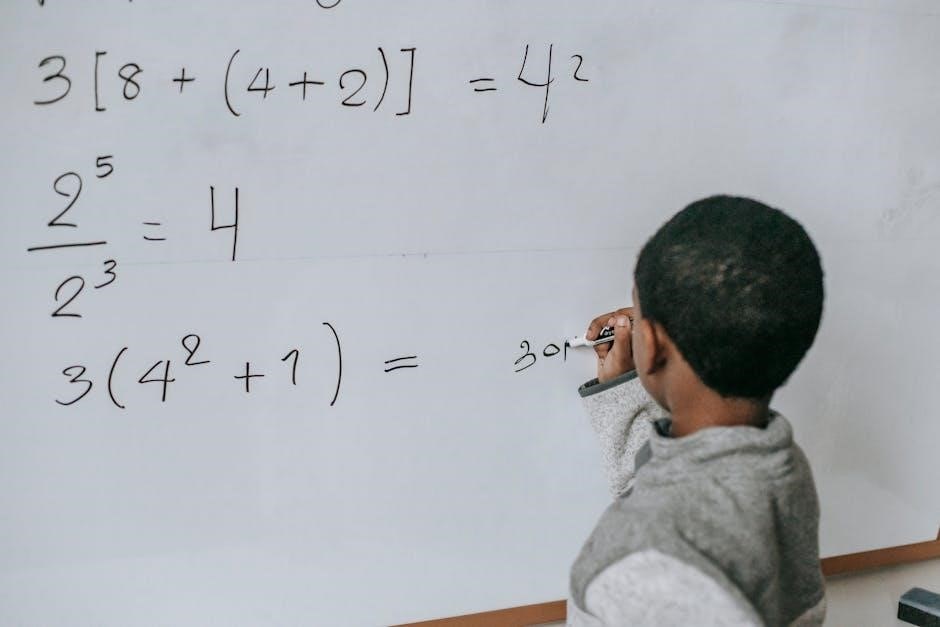Understanding Two-Step Equations
Two-step equations involve mathematical problems solvable in only two steps․ These equations typically include an operation of addition or subtraction, followed by multiplication or division․ Understanding these equations is crucial for building a strong foundation in algebra and problem-solving skills․
Definition of Two-Step Equations
A two-step equation is an algebraic equation that requires exactly two mathematical operations to isolate the variable․ These operations typically involve a combination of addition or subtraction, followed by multiplication or division, or vice versa․ The goal is to simplify the equation step-by-step until the variable stands alone on one side, revealing its value․
Unlike one-step equations, which can be solved with a single operation, two-step equations introduce an additional layer of complexity․ This requires a deeper understanding of inverse operations and the order in which they should be applied․ Mastery of these equations is a fundamental stepping stone towards tackling more complex algebraic problems․
For instance, consider the equation 2x + 3 = 11․ To solve for ‘x’, one must first subtract 3 from both sides, resulting in 2x = 8․ Then, divide both sides by 2 to find x = 4․ These two distinct steps define the essence of a two-step equation․ They are important because they are solvable․ It uses inverse operations to solve․
Components of a Two-Step Equation
A two-step equation consists of several key components working together․ First, there’s the variable, typically represented by a letter like ‘x’ or ‘y’, which stands for the unknown value we aim to find․ Then, there’s a coefficient, a number multiplied by the variable, indicating how many times the variable is being considered․
Next, we have a constant term, a numerical value added to or subtracted from the variable term․ Finally, there’s the equality sign (=), which signifies that the expression on the left side of the equation is equivalent to the expression on the right side․
For example, in the equation 3x + 5 = 14, ‘x’ is the variable, ‘3’ is the coefficient, ‘5’ is the constant term, and ’14’ is the value on the other side of the equality sign․ Understanding these components is crucial for effectively manipulating the equation and isolating the variable․ Recognize that each component has a special role in the function․ Knowing what they are can help you solve them․

Solving Two-Step Equations
Solving two-step equations involves isolating the variable through inverse operations․ This typically means undoing addition or subtraction first, and then undoing multiplication or division․ By following these steps, we can determine the value of the unknown variable effectively and accurately․
Using Inverse Operations
To effectively solve two-step equations, it’s essential to master the concept of inverse operations․ Inverse operations are mathematical actions that undo each other․ For example, addition is the inverse of subtraction, and multiplication is the inverse of division․ When solving equations, we use inverse operations to isolate the variable․
The goal is to manipulate the equation in a way that the variable is by itself on one side of the equals sign․ To do this, we apply the inverse operation to both sides of the equation, maintaining the balance․ If the equation involves addition, we subtract; if it involves subtraction, we add․ Similarly, if the equation involves multiplication, we divide; and if it involves division, we multiply․
This process ensures that the equation remains equal while we gradually simplify it, ultimately revealing the value of the variable․ Understanding and applying inverse operations correctly is the key to successfully solving two-step equations and other algebraic problems․ It’s a fundamental skill that builds a solid foundation for more advanced math concepts․
Isolating the Variable
Isolating the variable is the primary objective when solving two-step equations․ This process involves strategically using inverse operations to get the variable alone on one side of the equation․ The variable represents the unknown value we are trying to determine, and isolating it allows us to find its solution․
The first step in isolating the variable typically involves addressing any addition or subtraction present in the equation․ We achieve this by performing the inverse operation on both sides, ensuring that the equation remains balanced․ Once the addition or subtraction is dealt with, we move on to multiplication or division․ Again, we apply the inverse operation to both sides to eliminate the coefficient multiplying or dividing the variable․
By following these steps systematically, we gradually peel away the layers surrounding the variable until it stands alone․ This process reveals the variable’s value, providing the solution to the equation․ Mastering the art of isolating the variable is crucial for success in algebra and beyond․
Checking Your Solution
Checking your solution is a vital step in solving two-step equations, ensuring accuracy and solidifying understanding․ After isolating the variable and finding a potential solution, it’s crucial to verify whether that solution truly satisfies the original equation․ This process involves substituting the obtained value back into the equation and evaluating both sides․
If the left-hand side (LHS) of the equation equals the right-hand side (RHS) after the substitution, the solution is correct․ This confirms that the value found for the variable makes the equation true․ However, if the LHS does not equal the RHS, it indicates an error in the solving process․ This discrepancy signals the need to revisit the steps taken to identify and correct the mistake․

Checking your solution not only validates the answer but also reinforces the understanding of equation solving․ It provides an opportunity to catch careless errors and deepen comprehension of the relationships between variables and operations․ This practice builds confidence and accuracy, essential skills for tackling more complex algebraic problems․

Two-Step Equations Worksheets
Two-step equations worksheets provide valuable practice for students learning algebra․ These worksheets offer a variety of problems, from basic exercises to real-world applications, helping students master the skills needed to solve these equations confidently and accurately․
Types of Problems Included
Two-step equation worksheets encompass a wide range of problems designed to reinforce different aspects of algebraic understanding․ These problems often include equations with integer coefficients, where students must perform addition or subtraction followed by multiplication or division to isolate the variable․ Some worksheets introduce negative coefficients, challenging students to work with signed numbers and apply the correct inverse operations․
Fractional and decimal coefficients are also common, requiring students to apply their knowledge of fraction and decimal arithmetic within the context of equation solving․ Worksheets may also include equations that require simplifying before solving, such as combining like terms or distributing a constant across parentheses․
Another type of problem involves equations with variables on both sides, which introduces an additional step of isolating the variable terms before applying the standard two-step solving process․ These diverse problem types ensure that students develop a comprehensive understanding of two-step equations and are prepared for more advanced algebraic concepts․
Word Problems and Real-World Applications
Two-step equation worksheets frequently incorporate word problems to bridge the gap between abstract algebraic concepts and practical scenarios․ These word problems require students to translate real-world situations into mathematical equations, enhancing their problem-solving and critical-thinking skills․ For example, a word problem might describe a scenario where a person buys several items and receives change, requiring students to determine the original price of each item․
Another common type of word problem involves geometric shapes, such as finding the dimensions of a rectangle given its perimeter and one side length․ By solving these problems, students learn to connect mathematical concepts with practical applications․
Real-world applications of two-step equations can be found in various contexts, such as calculating costs, determining distances, and solving mixture problems․ Worksheets often present these applications in an engaging and accessible manner, helping students to understand the relevance and usefulness of algebra in everyday life․ These problems not only reinforce algebraic skills but also promote a deeper understanding of mathematical modeling and problem-solving strategies․
Benefits of Using Worksheets
Worksheets offer numerous benefits in mastering two-step equations․ They provide structured practice, enabling students to reinforce concepts and develop fluency in solving equations․ Worksheets often include a variety of problems, ranging from basic to more challenging, allowing students to gradually increase their proficiency․ This progressive approach helps build confidence and reduces the likelihood of frustration․
Furthermore, worksheets can be tailored to address specific learning needs․ Teachers can select worksheets that focus on particular types of problems, such as those involving fractions, decimals, or negative numbers․ This targeted practice allows students to overcome specific challenges and solidify their understanding․
Additionally, worksheets provide immediate feedback․ Many worksheets come with answer keys, enabling students to check their work and identify errors․ This self-assessment helps students learn from their mistakes and improve their problem-solving skills․
Finally, worksheets are a valuable tool for assessment․ Teachers can use worksheets to gauge student understanding and identify areas where additional instruction is needed․ This information can then be used to adjust teaching strategies and provide targeted support․

Creating Two-Step Equations from Word Problems
Transforming word problems into two-step equations is a critical skill in algebra․ It involves translating real-world scenarios into mathematical expressions that can be solved to find unknown quantities․ This process requires careful reading and understanding of the problem, as well as the ability to identify the key information needed to form the equation․
The first step in creating a two-step equation from a word problem is to define the variable․ This involves choosing a letter, such as ‘x’, to represent the unknown quantity that you are trying to find․ Next, identify the operations that are being performed on the variable․ These operations may include addition, subtraction, multiplication, or division․
Once you have identified the variable and the operations, you can write the equation․ Be sure to follow the order of operations (PEMDAS) to ensure that the equation accurately reflects the problem․ Finally, solve the equation using inverse operations to find the value of the variable․ Check your solution by plugging it back into the original word problem to ensure that it makes sense in the context of the problem․

